Troubleshooting a cloud flow
Here are some tips and tricks for troubleshooting cloud flows.
Identify specific flow runs
Once you build and deploy your flows, you might need to debug specific flow runs to confirm that your flow ran as expected. By default, the flow owner can look at the Start, Duration, and Status columns in the run history view in Power Automate to help them identify the flow run they are interested in debugging. The owner can also expand the troubleshooting section to identify the specific run in which they are interested, however, for flows that run frequently, this can be time-consuming.
To make it more efficient to identify flow runs when debugging, Power Automate provides the ability for flow owners to configure the list of columns that's displayed on the run history page for each flow run. These columns map to the trigger outputs for your flow. When you display the columns you want, you save time since you will see the relevant columns by default on the run history view.
Follow these steps to add one or more columns to your run history view.
Sign in to Power Automate.
Select My flows from the left side of the screen.
Select the flow for which you want to get more details.
Select Edit columns on the flow details page.

Select the columns that you want to add to your run history view for the flow that you've selected, and then select Save.
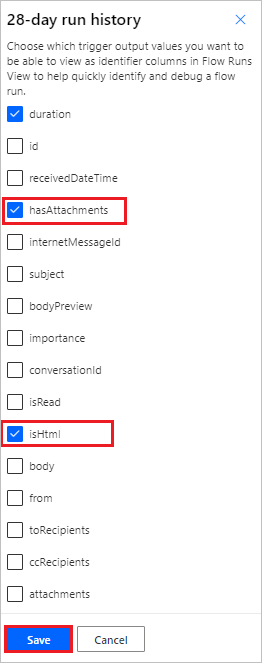 .
.View the list of columns that displays on the run history view for the flow you've selected.
Note that hasAttachments and isHTML columns are now visible for the flow so that you can quickly see those values to help you debug the flow.
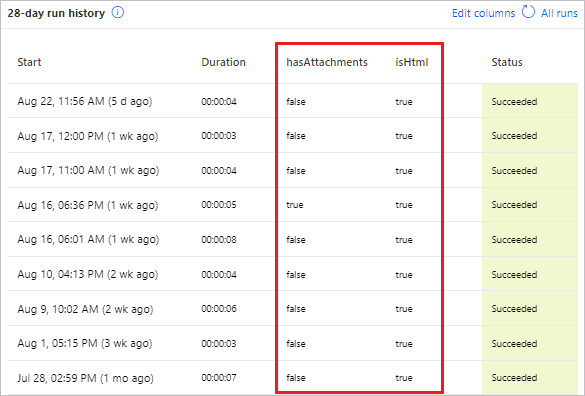
Tip
You can also configure the list of columns that's displayed via the All runs view.
Repair tips in email
Repair tips are sent to flow owners via email whenever a cloud flow fails. These repair tips emails contain specific, actionable feedback about certain errors. For example, one common error is setting up a cloud flow that attempts to get a person’s manager in Office 365—but there is no manager configured in Microsoft Entra ID. If this or several other conditions cause your flow to fail, you get a repair tips email like this:
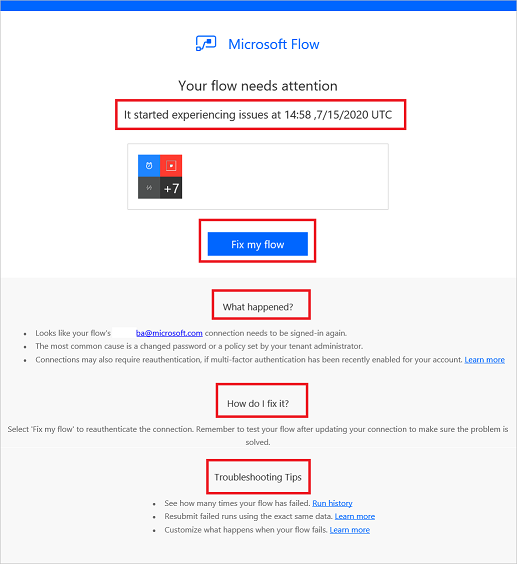
The repair tips email contains the following sections:
| Name | Description |
|---|---|
| Time | Displays the time the flow first failed. |
| What happened | Provides a description of the problem that caused the failure in the flow. |
| How do I fix | Provides tips for resolving the issue that cause the failure in the flow. |
| Troubleshooting Tips | Provides details including the number of times the flow failed, and a link to retry the flow with the same input data. |
To fix the reported errors, select Fix my flow and follow the steps in the repair tips email.
Repair tips emails are optional. If you don't want to receive them, just turn them off from the properties menu for the specific flow.
If your flow fails, you can also troubleshoot it directly in Power Automate. Here are a few common failure scenarios and tips on how to fix them.
Identify the error
Select My flows.
Select the flow that failed.
In the 28-day run history section, select the date of the failed run.
Details about the flow appear, and at least one step shows a red exclamation icon.
Open that failed step, and then review the error message.
On the right pane, you can see the details of the error and How to fix the error.
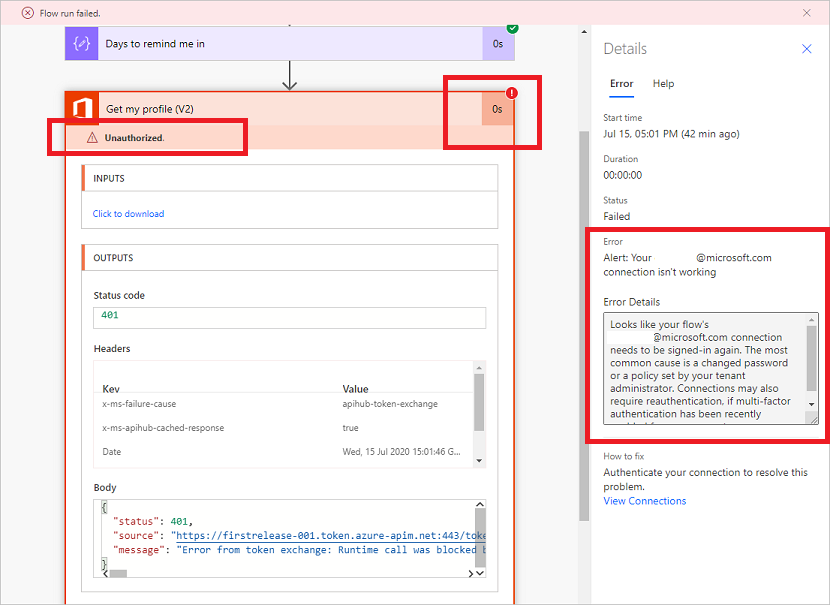
Authentication failures
In many cases, flows fail because of an authentication error. If you have this type of error, the error message contains Unauthorized or an error code of 401 or 403 appears. You can usually fix an authentication error by updating the connection:
In the right pane, click on View Connections below How to fix.
Scroll to the connection for which you saw the Unauthorized error message.
Next to the connection, click or tap the Fix connection link in the message about the connection not being authenticated.
Verify your credentials by following the instructions that appear, return to your flow-run failure, and then click or tap Resubmit.
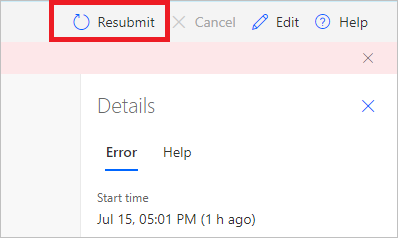
The flow should now run as expected.
Action configuration
Flows also fail if a setting in an action of the flow doesn't function as expected. In this case, the error message contains Bad request or Not found, or an error code of 400 or 404 appears.
The error details should specify how to correct the failure. You'll need to click or tap the Edit button and then correct the problem inside the flow definition. Save the updated flow, and then click or tap Resubmit to try the run again with the updated configuration.
Other failures
If the error code 500 or 502 appears, the failure is temporary or transient. Click or tap Resubmit to try the flow again.
Getting help from support or the community
When you need help, you can use our Self Help options, or you can Ask for help from others.
Self help
Go to the support site.
Go to the Self Help category and select one of the self-help options.

Ask for help from others
Go to the support site.
Select Contact Support in the Ask for help section.
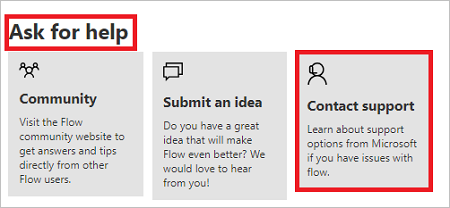
Complete the Problem type, Category, and the Tell us what you need help with fields, and then select See solutions.
Notice that the Solutions section displays after you select See solutions. It contains a list of results that you can use to help address the issue you're facing.
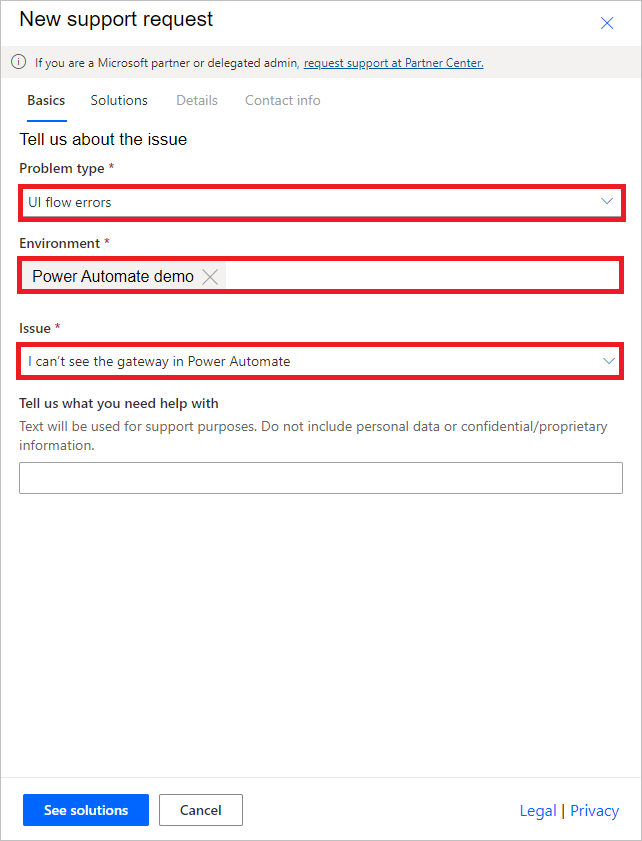
If you need help with an issue, help is available from our community and Microsoft.
Feedback
Coming soon: Throughout 2024 we will be phasing out GitHub Issues as the feedback mechanism for content and replacing it with a new feedback system. For more information see: https://aka.ms/ContentUserFeedback.
Submit and view feedback for